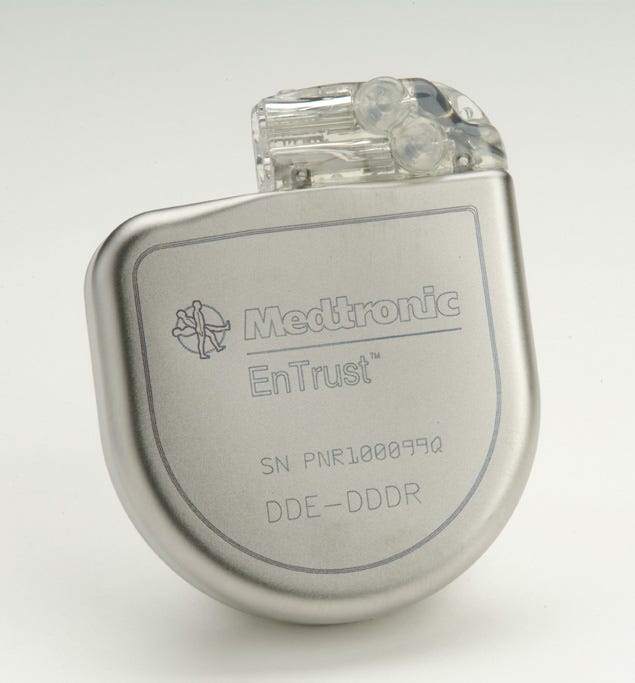March 21, 2012
It's been a rough month for Medtronic's implantable cardioverter-defibrillator (ICD) business. The medical device industry giant has been squirming in the hot seat after issuing a safety warning to physicians on March 6 notifying them of a small risk of premature battery depletion in certain models of the company's EnTrust and Escudo lines of ICDs. And as patient panic probably mounts, the industry awaits any word or evaluation of the warning from FDA, and lawyers likely prep for battle, the power-related defect underscores the potential market for emerging energy harvesting technologies for cardiac rhythm-management devices.
|
Medtronic has issued a safety warning for its EnTrust ICD owing to a small risk of premature battery depletion in certain models. Image courtesy of Medtronic. |
At the root of the ICD issue is an internal short circuit in the battery that can develop as capacity is consumed, often occurring about 2.5 years after implantation. "Typically, these heart devices have three months of normal operation after the device signals the need for replacement," Medtronic spokesperson Tracy McNulty told MedCity News. "EnTrust devices may require replacement sooner than expected, and result in less than three months of normal operation once the device indicates the need for replacement." As a result, the battery could run out sooner than anticipated, thereby losing the ability to pace or shock the heart as needed.
In response to Medtronic's warning, British regulators at the Medicines and Healthcare Products Regulatory Agency (MHRA) issued a medical device alert last week for the EnTrust ICD. The agency stated that, based on available data, affected EnTrust ICDs demonstrated a rapid voltage decline from elective replacement indicator (ERI) to end of life (EOL) ranging from 96 days to 6 days, with a mean of 41 days. On the bright side, no patient deaths or serious injuries have been reported, according to Medtronic. Furthermore, the company asserts that the battery issue has been identified in less than 0.1% of the models.
To address the issue, MHRA states that all cardiologists and cardiac physiologists should follow up with EnTrust ICD patients within one month if the device has been implanted for longer than 28 months and within three months for other cases. Physicians should test for audible alerts indicating low battery voltage ERI and excessive charge time EOL; advise patients to act immediately if the alert should sound; and track and compare battery voltages during visits for evidence of rapid voltage drop. In addition, the agency recommends that doctors replace ICDs in which the ERI has been reached in the presence of such a rapid battery voltage drop within two weeks; review patients every three months; and ensure that patients are enrolled in the CareLink program for monitoring and discussion. MHRA doesn't, however, recommend replacement of EnTrust ICDs unless absolutely necessary.
With all of this hubbub surrounding batteries and power issues for cardiac rhythm-management devices, it's hard to prevent one's mind from wandering to the heavily researched area of energy harvesting as a supplemental or autonomous power source. After all, if commercialized, these technologies could eliminate many of the issues presented by battery use and size in such medical implants as ICDs and pacemakers.
And potential power sources are diverse, to say the least. Researchers are exploring options for harvesting energy from irregular vibrations such as walking, from natural body movements such as breathing, from wasted energy, and from differential energy in the chambers of the human heart. Most recently, researchers at the University of Michigan (Ann Arbor) designed a technology to harvest the ambient vibrations from the reverberation of heartbeats through the chest and convert them to electricity to power ICDs and pacemakers.
But that's not to say these energy-harvesting technologies are the panacea for pacemakers and ICDs. They present their own unique challenges, after all. "Energy harvesting can power a pacemaker infinitely long, but at any instant, what is that requirement for the amount of power that I need?" said Guarav Jain, senior research manager, battery research, at Medtronic during a presentation at MD&M West in February. "On the energy-harvesting side, it's [also] important that there are certain engineering wear-out mechanisms; that's where the limitation would come in as to longevity."
So, while there are still a lot of challenges and issues to work out in terms of energy harvesting for implant powering, it's certainly an exciting research area. The need for such innovative technologies is becoming increasingly evident, after all, as implants continue to shrink--leaving less real estate for bulky batteries--and battery-related defects, as seen in Medtronic's EnTrust ICD, draw unwanted scrutiny while potentially putting patients at risk. --Shana Leonard
You May Also Like



